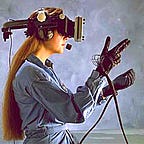Fashion for Six Feet of Separation
New dynamics between people and everything we touch
When I wrote about face masks as the first sign of dystopia in January, I was still traveling by plane back and forth from Chicago to New York on a weekly basis to teach in the classroom at Parsons. It was still the commonly understood CDC guideline that masks were not effective for people without illness, and that healthy people should leave masks for those who needed them the most: the healthcare workers and other employees fulfilling essential services, and the sick. SXSW was still on the calendar.
Now in mid May, with stay at home guidelines extended across most of the United States, and some deciding to test the waters of life at six-feet apart, the mask is as pervasive as it is diverse. Not only because they are now nearly impossible to find, as a civilian and consumer, but the guidelines to leave them for our front line workers, the vulnerable and the ill have essentially been reversed. The demand for masks has outpaced the market, and a DIY culture has emerged.
Brands and newspapers released patterns for people to cut and sew their own, from fabric they had on hand or from old clothes or linens.
Fashion has historically used face coverings for aesthetics and commentary. Fashion is now embracing the mask from a much more pragmatic point of view.
It makes sense that masks would become fashion accessories that we would keep on hand, like our winter hats and gloves that we wear as needed, and store as needed. But what about the rest of our bodies? In particular our hands, but really every part of us, that could make us more exposed?
Until a vaccine is widely available, people will continue to be at risk. And even once risk is no longer imminent, how will we equip ourselves for the possibility of future pandemics that threaten the normal flow of populations?
Fashion has always been a mediator between ourselves and our environment. This new role is out of scope for so much of our clothing today, making us feel covered but still vulnerable and exposed.
Personal Protective Equipment (PPE) has been the first line of defense for healthcare workers and other essential workers interacting with people, both sick and healthy, on a daily basis. Masks have been the first element of that uniform to take on “accessory” status for fashion brands, some of which already offered them either as a niche accessory or a statement piece related to subculture.
As fashion is undergoing its own identity crisis, one way brands are finding new purpose is in addressing the real and immediate needs of people. This might mean fewer resources are put into planned product launches or existing product lines in order to prioritize the production of PPE. It requires creating new patterns and adjusting supply chains and working with partners to create new timelines and resourcing plans. Could it also mean product innovation, and opportunity for R&D for our clothing to become more functional?
As mediator, fashion could not only physical, but also psychological safety as we transition from life at 6 feet apart.
